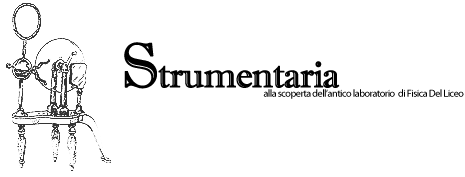Meccanica dei gas
- 1 Apparecchio degli emisferi di Magdeburgo
- 2 Banco per il vuoto
- 3 Crepavesciche
- 4 Pallone pesa aria
- 5 Pompa a mano in ottone
- 6 Barometro aneroide smaltato per dimostrazione
- 7 Barometro Fortin
- 8 Baroscopio
- 9 Eudiometro del Volta
- 10 Igrometro a capello
- 11 Igrometro Saussure
- 12 Pistola del Volta
-
 The machine is used to show the effects of air pressure. Otto Von Guericke (1602–1686), who discovered the air pump, invented it in 1646.
The machine is used to show the effects of air pressure. Otto Von Guericke (1602–1686), who discovered the air pump, invented it in 1646. -
 It is a pneumatic machine used to create the vacuum, at different pressure levels, within the bell or in closed containers joined to the nozzle it is equipped with.
It is a pneumatic machine used to create the vacuum, at different pressure levels, within the bell or in closed containers joined to the nozzle it is equipped with. -
 The appliance allows to show the action of atmospheric pressure. The progressive pulling out of the air from the apparatus, in fact, produces the breaking of the starting balance between the external atmospheric pressure and the internal one, underlining the prevalence of the external pressure.
The appliance allows to show the action of atmospheric pressure. The progressive pulling out of the air from the apparatus, in fact, produces the breaking of the starting balance between the external atmospheric pressure and the internal one, underlining the prevalence of the external pressure. -
 The device was used by several scientists, among whom Otto von Gueriche, who started again the experiments made by Galilei, to weight the air it contained.
The device was used by several scientists, among whom Otto von Gueriche, who started again the experiments made by Galilei, to weight the air it contained. -
 A pump used for experiments on pressure. The first model of a hand pump, very alike a bicycle pump, was invented by Robert Boyle (1627-1691) with his assistant Robert Hooke in Oxford in the 17th century. At the beginning of the 19th century, in England, there was a widespread use of the Hauksbee model with two cannulas, a variation of the original model with one cannula, invented by Musschenbroek in 1695 and used in Holland.
A pump used for experiments on pressure. The first model of a hand pump, very alike a bicycle pump, was invented by Robert Boyle (1627-1691) with his assistant Robert Hooke in Oxford in the 17th century. At the beginning of the 19th century, in England, there was a widespread use of the Hauksbee model with two cannulas, a variation of the original model with one cannula, invented by Musschenbroek in 1695 and used in Holland. -
 It is a barometric system contained in a metal box in such a way as to allow the observation of the inside mechanism.
It is a barometric system contained in a metal box in such a way as to allow the observation of the inside mechanism. -
 Fortin’s barometer is a mercury one which measures the atmospheric pressure, determining, as in Torricelli experience, the pressure exercised by a column of mercury that balances the atmospheric pressure.
Fortin’s barometer is a mercury one which measures the atmospheric pressure, determining, as in Torricelli experience, the pressure exercised by a column of mercury that balances the atmospheric pressure. -
 An instrument that can experimentally verify the validity of Archimede’s Principle as far as gases are concerned.
An instrument that can experimentally verify the validity of Archimede’s Principle as far as gases are concerned. -
 The eudiometer, which is used in chemistry for the analysis of gases, is an appliance based on the chemical effects of electricity. Eudiometers were commonly used by A. Volta to test the breathing quality of the air.
The eudiometer, which is used in chemistry for the analysis of gases, is an appliance based on the chemical effects of electricity. Eudiometers were commonly used by A. Volta to test the breathing quality of the air. -
 The instrument is an absorption hygrometer; its working is based on the properties that some organic, animal and plant substances have to lengthen with humidity and to shorten with dry weather.
The instrument is an absorption hygrometer; its working is based on the properties that some organic, animal and plant substances have to lengthen with humidity and to shorten with dry weather. -
 A hair hygrometer, used to measure humidity variations. Such an instrument was part of Saussure’s equipment while he was climbing Mount Bianco, surveying scientific data.
A hair hygrometer, used to measure humidity variations. Such an instrument was part of Saussure’s equipment while he was climbing Mount Bianco, surveying scientific data. -
 The device, invented by A. Volta (1745 – 1827), shows the explosive chemical effects produced by an electric spark in suitable gas mixture.
The device, invented by A. Volta (1745 – 1827), shows the explosive chemical effects produced by an electric spark in suitable gas mixture.

